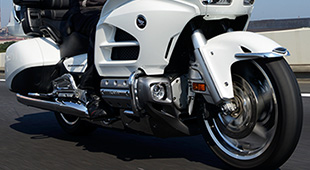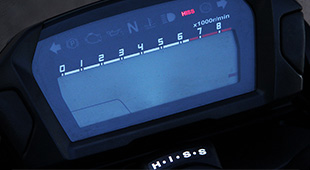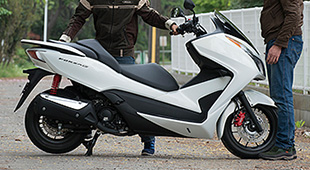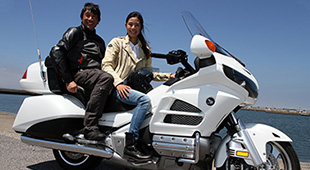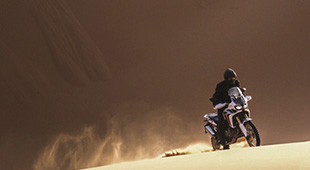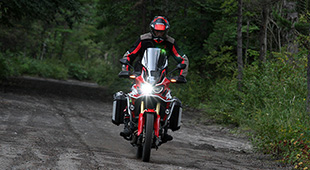Tech Views — Vol.1 Dual Clutch Transmission
NC750S / NC750X (Dual Clutch Transmission)
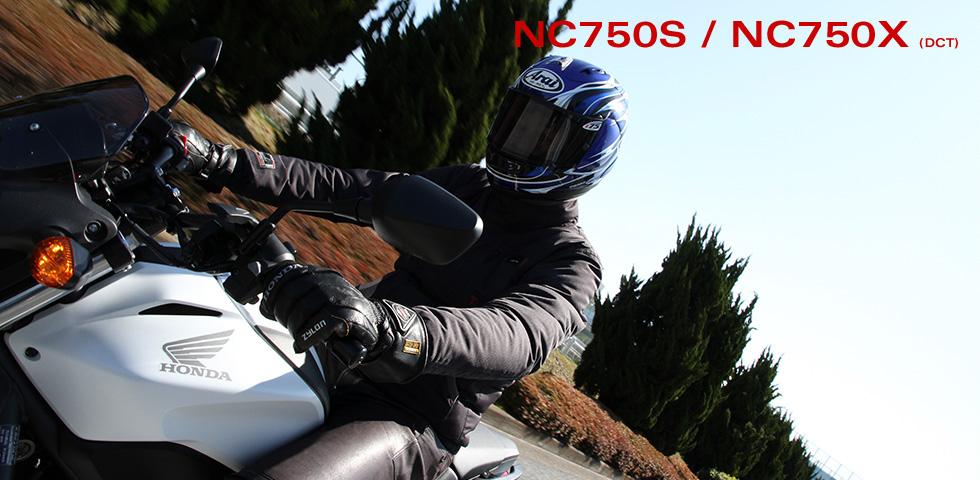
NC750S / NC750X (Dual Clutch Transmission)
Honda's Dual Clutch Transmission is lots of fun, and here are the reasons why.
That refreshing feeling of the wind in your face and a sense of oneness with the world - these are the elements that stimulate our senses and give us the most joy when riding sports bikes. Although my job requires me to ride a lot of different bikes, one of my personal points of evaluation of a good bike is whether its peak level of enjoyment can be felt soon after the ride begins. There are, of course, many intertwined factors involved, and all ultimately depends more on how deeply one can enjoy the riding experience than on how high or low the bike's absolute performance is.
The Dual Clutch Transmission installed in Honda's New Mid Concept series NC750X and NC750S models is a prime example of what I'm talking about.
First debuted in Honda's VFR1200F flagship sports tourer, the Dual Clutch Transmission eliminates the need to operate the clutch, and in its 'AT' mode it automatically selects the most appropriate gear for riding conditions. In 'MT' mode, its electronically-controlled transmission allows the rider to select gears by 'shifting' with a pair of thumb and finger-operated switches.
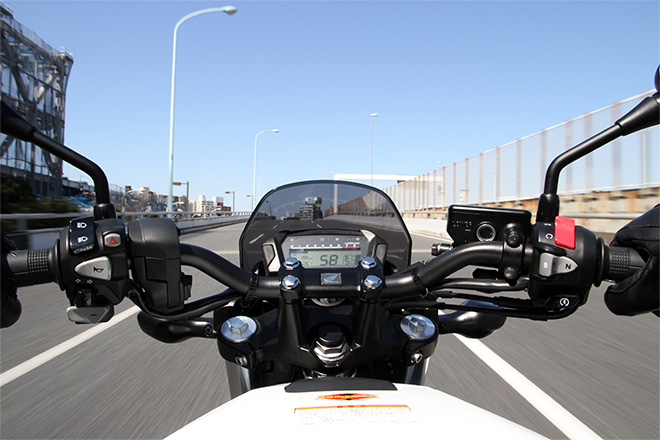
Completely different from the belt-type (or CVT) transmissions used by most scooters, the Dual Clutch Transmission used in the NC Series machines is structurally based on a conventional 6-speed gear ratio transmission, yet electronically controls clutch and shift operations when changing speeds.
Until I experienced Honda's Dual Clutch Transmission, I believed that having a clutch lever and a gear change pedal made a motorcycle a true sports bike. My guess is that you feel the same. Because of this, except for the occasional scooter, my riding history had never included any bike that didn't have a clutch lever. However, once I actually rode a Dual Clutch Transmission machine, I was surprised by how quickly my thinking changed.
I thought, "Maybe clutch and shift pedal operation are not necessarily central to sports bike riding enjoyment." But what made my thinking change? Perhaps my years of experience riding sports bikes till then allowed me to discover a wider world.
First, just imagine the scene when starting out. Compared to normal manual clutch and transmission models, a bike equipped with the Dual Clutch Transmission completely eliminates the nervous tension of possible engine stalls. I'd always thought such tension, and the ability to achieve consistently smooth starts, was one of the pleasures of sports bike riding. So, when riding a Dual Clutch Transmission bike, I never think to myself, "That start was great!"
If asked if this has a negative impact, I'd have to say the answer is no. Conversely, being freed from the operation of the clutch lever enabled me to concentrate more on my right hand's throttle operation, letting me more closely feel the engine's generation of torque, its changes in sound and the instant movement begins.
Riding the NC750S, when I come to a busy intersection, stop, and check for oncoming traffic before taking off again, I don't have that momentary twinge of worry about getting into trouble (and the big embarrassment that follows!) by stalling the engine. Rolling on the throttle simply rolls on the NC's engine torque and lets me take off with quick and smooth confidence. As motorcyclists, we've got to be mindful of oncoming cars, pedestrians, route changes, left mirror, right mirror and many other factors calculated from all angles while simultaneously operating the clutch, throttle and gear shift lever. With the elimination of these last three operations, I found I could ride with a surprising degree of concentration and ease.
In AT mode, simply toggling the transmission selector switch to 'D' and turning the throttle enables the Dual Clutch Transmission to automatically perform all 6-speed gearbox operations referenced to speed. Closing the throttle to slow down also results in automatic downshifts. While riding through town, I noticed that I had more room to think of other things besides basic operation and safety, such as the enjoyment to be found in the discovery of a new café.
Then I got on the expressway and cranked open the acceleration, eventually settling into a high-speed cruise. Here even regular manual transmission bikes stay in top gear without shifting, so no difference was felt at all. Even when speeding up to pass another vehicle, the Dual Clutch Transmission performed all necessary operations with just a twist of the throttle. Gear changes were smooth and beautifully done, like hiring a professional rider to control the gearbox. Of course, since downshifts can also be performed with the manual touch of a button, I felt I could ride the way I like, leaving no feelings of dissatisfaction anywhere.
Coming to a road leading up and over a mountain pass, I wondered if any drawbacks would show up in the Dual Clutch Transmission's operation compared to a manual transmission. The short answer is no. I was able to enjoy a level of riding control on par with, if not actually exceeding that of a normal manual transmission. Winding roads have all sorts of curves to them, from sweepers to sharp hairpins. One of the highlights of riding a winding road is the feeling of one's senses sharpening as one scene unfolds after the next. What gives corning a special satisfaction is holding a line while concentrating on the acceleration and deceleration of throttle operation. Riding with the Dual Clutch Transmission, gear shifts were completely automatic, or I could make those changes like a pro using just the finger and thumb of my left hand. This clearly seemed to provide a heightened level of concentration that allowed me to focus ahead around the curve or when slowing down.
At first I couldn't believe that eliminating gear shift operation could possibly make riding easier, but then I discovered the deeper sense of enjoyment the Dual Clutch Transmission has to offer, and I was surprised to find I'd become a firm believer after riding over that first pass. Much like in town, I could feel the same deep sense of the engine's power in the turns in response to a simple twist of the throttle.
In other words, the Dual Clutch Transmission isn't just an automatic transmission designed to make riding easy like a scooter. It instead plays a vital role as a device that greatly increases the purity of the riding experience.
Honestly speaking, in the over 30 years I've been riding motorcycles, I think I've managed to sharpen my riding skills from many angles, including clutch and shifting operations and throttle control. I've also had some experience in off-road riding as a hobby, and for my work have ridden on circuits used for MotoGP races. The capabilities of the Dual Clutch Transmission's clutch work and gear shift operations now closely approximate my own riding techniques developed in these different arenas. Actually, I'm not really being completely honest. The Dual Clutch Transmission totally surpasses my own skills in that it makes no miss shifts at all.
What can't be forgotten is not only the fact that it never makes an error in shifting. Another important feature of the Dual Clutch Transmission is that when shifting up under acceleration, its two clutches are interlocked through an otherwise conventional manual transmission, and it completes the shift operation in a remarkably short time frame. Therefore, up or down, it smoothly completes the shift with virtually no intermittent pauses, and thus reduces the load to the bike. So, although I've worked long and hard over the years to perfect my throttle control, my clutch work and my shifting, the Dual Clutch Transmission provides an exceptional riding solution that makes me an even better rider, and helps me more fully enjoy my riding experience.
In particular, as I'm sure riders who have a lot of experience riding double know all too well, gear shifts can often result in rider and passenger helmets bumping together. Another of the great side benefits of the Dual Clutch Transmission is that it frees riders from having to take special care to shift smoothly in order to avoid such frequent impacts. Shifting can be done at will with fully automated clutch operation.
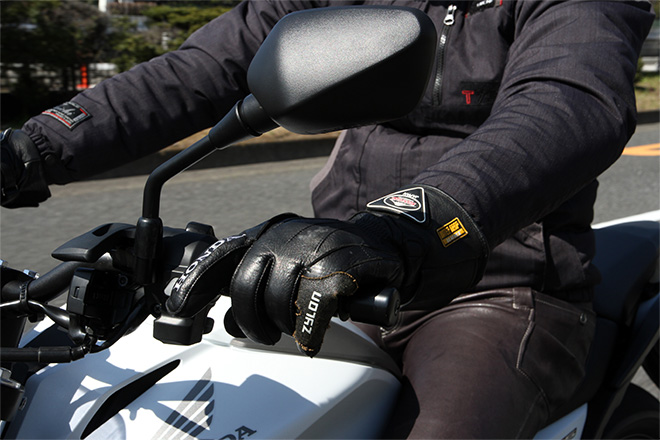
Motorcycles have continued to evolve since I first began to ride, and I think this trend will continue further. Within such a time frame, I think the Dual Clutch Transmission is a mechanism that has great possibilities.
While the NC750X offers the feeling of an adventure tourer, the NC750S represents a new genre in naked sports bikes. Both have large luggage boxes that make it possible to pack quickly when going out for a long ride. Both are designed with an emphasis on space utility and feature the Dual Clutch Transmission. Automating both the clutch and gear shifting operations increases the pleasure of riding and causes a new bike world to unfold in town, while enjoying winding roads, or even when riding double with a friend or someone closer. Personally, I'd like as many people as possible to experience what these bikes have to offer.
If I were asked to tell how big a shock discovering the capabilities of the Dual Clutch Transmission was for me, I can express it as something like "before and after my first mobile phone." You might well wonder if this is true, so by all means discover this remarkable system for yourself. Do a search for online blogs and Facebook pages put up for and by Dual Clutch Transmission riders, and check out the Dual Clutch Transmission at your nearest Honda dealer until you can obtain a satisfactory answer.
Prejudice will be your own loss, and the waste of a new world filled with exciting possibilities.
The Dual Clutch Transmission logo appearing on this cover gives a subtle hint of the superb riding enjoyment offered by this device.
The gray switches on the left-side switch module allow the rider to perform manual shift operation. Press the [-] switch for downshifts and the [+] button to shift up, as shown here.
The Dual Clutch Transmission automatically switches into neutral when the ignition key is turned on. After the engine is started, simply toggle the S-D-N thumb switch from N to D, then roll on the throttle to start riding. The AT/MT selector switch lets the rider choose either AT (Automatic) or MT (Manual) modes. That's all the knowledge required for operation.The Dual Clutch Transmission's capabilities are equal to 10 years of riding experience.
TRANSMISSION TECHNOLOGIES
- DUAL CLUTCH TRANSMISSION -
Honda has developed a motorcycle transmission with automated clutch and shift operation that delivers the same riding enjoyment as a manual transmission.
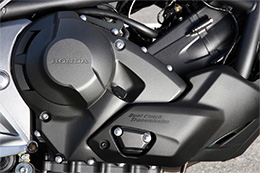
The Dual Clutch Transmission logo appearing on this cover gives a subtle hint of the superb riding enjoyment offered by this device.

The gray switches on the left-side switch module allow the rider to perform manual shift operation. Press the [-] switch for downshifts and the [+] button to shift up, as shown here.
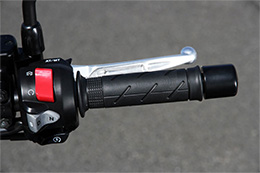
The Dual Clutch Transmission automatically switches into neutral when the ignition key is turned on. After the engine is started, simply toggle the S-D-N thumb switch from N to D, then roll on the throttle to start riding. The AT/MT selector switch lets the rider choose either AT (Automatic) or MT (Manual) modes. That's all the knowledge required for operation.The Dual Clutch Transmission's capabilities are equal to 10 years of riding experience.
TRANSMISSION TECHNOLOGIES - DUAL CLUTCH TRANSMISSION -
Honda has developed a motorcycle transmission with automated clutch and shift operation that delivers the same riding enjoyment as a manual transmission.
- TOP
- VFR1200F
- VFR1200X
- NC700S
- NC700X
- CTX
- NC750S / NC750X
- Africa Twin
- X-ADV
- Q&A
- User Reviews

